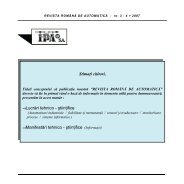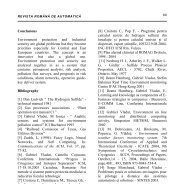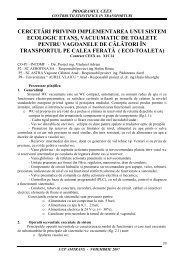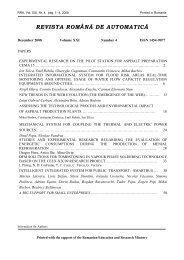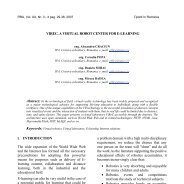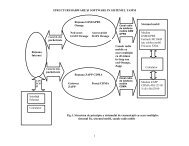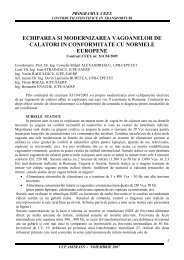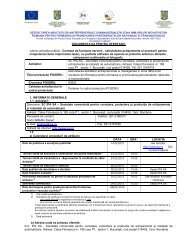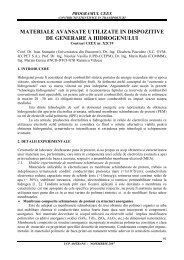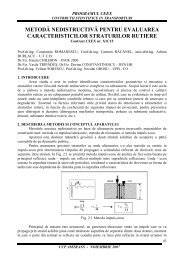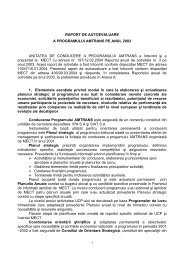0_ CUPRINS - IPA SA
0_ CUPRINS - IPA SA
0_ CUPRINS - IPA SA
You also want an ePaper? Increase the reach of your titles
YUMPU automatically turns print PDFs into web optimized ePapers that Google loves.
online, for: estimation of the solar energy that can be collected<br />
from tilted surfaces; PV system design; architectural solutions;<br />
- Database containing measurements of solar energy<br />
collectable from tilted surfaces;<br />
- Submission to the authorities of the legal requirements<br />
related to the authorisation of the operation of distributed<br />
electric power sources;<br />
- Organisation of a thematic competition („Solar house”) for<br />
students;<br />
- Organisation of workshop for discussing the results of the<br />
project with representatives of the target groups;<br />
- Brochures, guidelines, bibliographies for the different target<br />
groups<br />
2. Main results:<br />
- Development of a database regarding the measurement of<br />
solar radiation on tilted surfaces in various points on<br />
Romania’s territory, with the involvement of the National<br />
Institute for Meteorology and Hydrology;<br />
- Specialisation of young architects (students in the last years<br />
or studying for the master’s or doctor’s degree) in the<br />
problems specific to solar architecture within the Universities<br />
in Bucharest and Timisoara;<br />
- Raising the awareness of local authorities and building<br />
contractors with regard to the benefits of using solar<br />
architecture;<br />
- Increasing the level of information of the population<br />
regarding distributed photovoltaic systems.<br />
3. Estimated profits and profitability:<br />
- Development of specialization in solar architecture, with<br />
great opportunities within the EU market;<br />
- Achievement of important steps in the development of the<br />
photovoltaic industry in Romania;<br />
- Possibility of capitalization of the results obtained<br />
by the project in Romania’s neighbouring countries;<br />
-Easy to install: Our attractive, flexible solar roof<br />
panel literally rolls right on. We manufacture the solar roofing<br />
systems in easy to handle modular rolls to allow for rapid<br />
installation at our customer’s sites. We employ experienced<br />
roofing professionals to install our products, with no disruption<br />
to your business.<br />
-Light weight: The solar panel weighs only 3.7kg/m 2<br />
allowing installation on existing facilities without exceeding<br />
roof loading limitations.<br />
-Powerful: The amorphous silicon panels enable<br />
maximum kilowatt-hour output, producing electricity using a<br />
wider spectrum of light than traditional crystalline technology.<br />
This feature enables the panels to produce electricity all day<br />
long, even when it is cloudy.<br />
-Rugged and durable: Durability to cope with<br />
challenging weather conditions, and stability to handle<br />
changing light and shade conditions, have been built into all<br />
our roofing products. In addition, our roof is sealed and<br />
bonded, providing a weather-tight, long-lasting roof that has<br />
no penetrations. All our roofs are backed by a 20 year<br />
guarantee and an operations & maintenance program.<br />
-Attractive appearance: Our unique electrical engineering<br />
integrates the solar array within the roofing assembly<br />
providing a neat and uncluttered roof surface.<br />
III. SHORT DESCRIPTIONS OF THREE DEMO PV SYSTEMS<br />
A. Demo System PV at UAUIM<br />
Four PV modules composed of mono-crystalline silicon<br />
SRP (270Wp, 26 kg, 1047 x 2028 x 89 mm) were mounted on a<br />
roof versant of the historical building of UAUIM –Bucharest.<br />
In order to find the optimal location for the PV modules one<br />
carried out a study of the building’s solar irradiance for each<br />
season. One analyzed several possibilities in terms of location<br />
and types of constructive assemblies. Along with the<br />
reconsolidation process an architectural and functional<br />
conversion of the attic took place, through setting up new office<br />
spaces. Illumination of the hall resulted on the axis of the attic,<br />
was achieved through solar tunnels. For night lighting one<br />
installed lamps in each terminal space covered by natural light<br />
through the solar tunnels. The reconsolidation and<br />
rehabilitation process also implied the replacement of both the<br />
roof framing and the roof covering, making it easier to integrate<br />
the PV modules in the roof [3][4].<br />
Figure 1. Electrical scheme of the PV system<br />
The versant on which the PV modules were mounted is<br />
south-west oriented, with a tilt angle of around 15 0 . The solar<br />
irradiance study showed that there were no objects that could<br />
shade the respective versant.<br />
Figure 2. PV modules mounting<br />
The Velux solar tunnel has a fixed tube (35 cm in diameter)<br />
with an inner reflector surface with 98% degree of reflection; it<br />
ends up with an internal lighting fitting with 4 mm thick heat<br />
insulation glass.<br />
14



